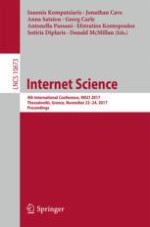2017 | OriginalPaper | Chapter
Serendipity by Design? How to Turn from Diversity Exposure to Diversity Experience to Face Filter Bubbles in Social Media
Author : Urbano Reviglio
Published in: Internet Science
Publisher: Springer International Publishing
Activate our intelligent search to find suitable subject content or patents.
Select sections of text to find matching patents with Artificial Intelligence. powered by
Select sections of text to find additional relevant content using AI-assisted search. powered by
